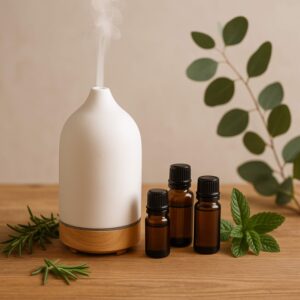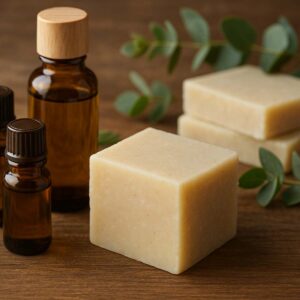How Solvent Extraction Works in Essential Oil Production
Introduction: When Steam and Cold Pressing Aren’t Enough
While steam distillation is the most common method for essential oil production, not all botanicals can withstand heat or high pressure. Delicate flowers such as jasmine, tuberose, gardenia, and violet lose much of their aroma when distilled.
For these botanicals, the industry relies on solvent extraction, a process that uses food-grade solvents like hexane or ethanol to gently extract volatile aromatic compounds. This method produces two intermediate products — concretes and absolutes — that are highly valued in perfumery, cosmetics, and luxury fragrance industries.
Solvent extraction allows access to oils that cannot be obtained by any other method, making it a cornerstone in the global essential oil and fragrance trade.
What Is Solvent Extraction?
Solvent extraction is a method in which plant material is treated with a solvent that dissolves aromatic compounds, waxes, and pigments. The solvent is then evaporated, leaving behind a concentrated product called a concrete.
- The concrete contains essential oils + plant waxes.
- To refine it, the concrete is washed with alcohol (ethanol).
- After chilling and filtering, the waxes are removed, and the final product is a highly concentrated absolute.
👉 Absolutes are luxury grade aromatic extracts used in perfumes and high end cosmetics.
The Science Behind Solvent Extraction
- Solvent Action: Non-polar solvents (like hexane) dissolve aromatic compounds and waxes.
- Concretes: Semi-solid mixtures of oil, resins, pigments, and wax.
- Absolutes: After alcohol washing, pure aromatic oil remains.
- Volatile Preservation: Because it avoids high heat, delicate aromatic molecules remain intact.
This makes solvent extraction especially useful for flowers whose fragrance cannot be replicated by distillation.
Step-by-Step Process of Solvent Extraction
Step 1: Preparing the Plant Material
- This method is commonly used for delicate flowers and resins that do not withstand heat well, such as jasmine, rose, tuberose, violet, and mimosa, as well as resins like benzoin or labdanum.
- Plant material must be harvested fresh and carefully handled, since older or bruised flowers lose volatile compounds quickly.
- Materials are gently cleaned and sometimes lightly chopped or spread thin to maximize contact with the solvent.
👉 The quality of the absolute depends heavily on the freshness and handling of the starting material.
Step 2: Solvent Treatment
- The prepared plant material is placed into large stainless-steel sealed drums or extractors.
- A non-polar solvent, most often hexane (sometimes petroleum ether or ethanol in food-grade applications), is circulated over the material.
- The solvent dissolves aromatic compounds, waxes, pigments, and lipophilic molecules from the plant.
- After repeated cycles, the solvent becomes saturated with aromatic compounds and is drained off for further processing.
👉 This stage allows for the extraction of delicate molecules (like indole in jasmine or damascenone in rose) that might be destroyed under heat in steam distillation.
Step 3: Filtration & Evaporation
- The solvent-aromatic mixture is filtered to remove plant debris.
- The solvent is then evaporated under reduced pressure (low temperature, vacuum-assisted evaporation) to prevent damage to the fragrance molecules.
- What remains is a “concrete” — a thick, waxy, semi-solid mass that contains:
- Aromatic compounds
- Natural waxes
- Plant resins
- Pigments (often giving the concrete its color)
👉 Concretes have a strong fragrance but are not directly usable in perfumery or cosmetics due to the high wax content.
Step 4: Alcohol Washing (Purification)
- The concrete is washed with food- or pharma-grade ethanol.
- The alcohol dissolves the aromatic molecules but not the waxes and heavy resins.
- The mixture is chilled to very low temperatures so that waxes solidify.
- Solidified waxes are filtered out, leaving an alcoholic extract containing only volatile aromatic compounds.
👉 This process is critical for producing a clean, usable perfume ingredient.
Step 5: Collection of the Absolute
- The ethanol solution is carefully evaporated under vacuum, leaving behind a highly concentrated aromatic extract called an absolute.
- Absolutes are liquid, intensely aromatic, and true-to-flower representations of the original plant.
- They are highly valued in:
- Perfumery (jasmine absolute, rose absolute, violet absolute)
- Luxury cosmetics (creams, serums, and oils)
- Aromatherapy (though less common than essential oils)
👉 Absolutes often carry the closest scent profile to the original flower, making them indispensable in high-end fragrance and cosmetic industries.
Essential Oils & Extracts Commonly Produced by Solvent Extraction
Jasmine Absolute 🌸 – luxury perfumery, skincare.
Tuberose Absolute 🌼 – high-end fragrance.
Rose Absolute 🌹 – perfumes, cosmetics.
Violet Leaf Absolute 🌿 – earthy, green note in perfumery.
Oakmoss Absolute 🌳 – grounding, base notes in colognes.
Vanilla Absolute 🍦 – premium flavoring and perfumery.
Advantages of Solvent Extraction
- Preserves delicate aromas that steam distillation would damage.
- Higher yields than distillation for some flowers.
- Produces concretes, absolutes, and resinoids, each with unique uses.
- Widely used in luxury fragrance and cosmetics.
Limitations and Challenges
- Solvent residue: High-quality absolutes must be tested to ensure <10 ppm solvent remains.
- Not suitable for aromatherapy ingestion: Many absolutes are not safe for internal use.
- Higher cost: Labor-intensive and solvent costs add to pricing.
- Limited scalability: Solvent extraction is specialized and not used for bulk commodity oils like peppermint or eucalyptus.
Applications Across Industries
1. Luxury Perfumery
Absolutes are indispensable in fine fragrance creation because they provide a true-to-flower scent profile that cannot be replicated by steam distillation.
- Jasmine absolute is one of the most expensive and treasured perfumery ingredients, often forming the heart notes of designer perfumes.
- Tuberose absolute gives rich, creamy floral depth, while rose absolute provides timeless elegance to both men’s and women’s fragrances.
- Absolutes also blend harmoniously with other natural or synthetic ingredients, giving perfumers a wider creative palette.
👉 This makes solvent extraction the backbone of the luxury fragrance industry, where scent authenticity is non-negotiable.
2. Cosmetics & Skincare
- High-end skincare and cosmetic brands incorporate absolutes for both fragrance and functional benefits.
- Rose absolute is added to anti-aging serums and creams for its skin-calming and rejuvenating qualities.
- Jasmine absolute enhances lotions and body oils, offering not just fragrance but also potential mood-lifting effects.
- Absolutes are particularly valued in luxury, clean-label, and artisan beauty products where authentic natural scent is a selling point.
👉 They help brands differentiate with premium positioning in the cosmetics market.
3. Pharmaceuticals & Herbal Medicine
- Some solvent-extracted compounds are used in traditional medicine and modern phytotherapy.
- Calendula absolute, for example, is valued for its wound-healing and skin-soothing properties.
- Clove absolute may be incorporated into oral care products for its antimicrobial activity.
- Absolutes provide standardized plant compounds, which makes them attractive for research into herbal-based formulations.
👉 While not as widespread as CO₂ extracts in pharma, solvent-extracted absolutes still have niche applications.
5. Flavoring (Specialty Foods & Beverages)
- Some absolutes (e.g., vanilla, cocoa, coffee) are used in premium food and beverage flavoring, especially where natural authenticity is required.
- Vanilla absolute is favored by gourmet chocolatiers and artisanal ice cream brands for its complex, rich profile.
- Floral absolutes like rose can be used in specialty confectionery, syrups, and exotic teas.
- Because of solvent residues and regulatory restrictions, only carefully processed absolutes that meet food-grade safety standards are approved for this market.
👉 This positions solvent extraction as a specialized flavoring tool for high-end culinary products.
How Buyers Can Judge Quality of Solvent-Extracted Oils
- GC/MS Testing – ensures minimal solvent residue.
- COA (Certificate of Analysis) – chemical profile.
- Smell Test – absolutes have richer, deeper aroma than steam-distilled oils.
- Supplier Reputation – absolutes are premium; fraud is common.
- Certifications – ISO, GMP, Organic if applicable.
Modern Innovations in Solvent Extraction
- Food-grade ethanol extraction – safer than hexane for consumable products.
- Enfleurage revival – using plant-based fats instead of solvents.
- Green solvents – like supercritical CO₂ as an alternative.
- Vacuum evaporation systems – reduce solvent exposure and improve purity.
FAQs About Solvent Extraction
Q1: Are absolutes safe for use in cosmetics?
👉 Yes, when solvent-free and properly purified, they’re widely used in perfumes and skincare.
Q2: Why not steam distill delicate flowers?
👉 Heat destroys their volatile compounds, so solvent extraction is the only way to capture their true aroma.
Q3: Do absolutes smell stronger than essential oils?
👉 Often yes — absolutes have a more complex, full-bodied scent.
Conclusion: Solvent Extraction and the World of Luxury Oils
Solvent extraction is essential for capturing the most delicate and exotic floral essences. While it has limitations — cost, solvent handling, and restricted use in aromatherapy — it remains irreplaceable in luxury perfumery, cosmetics, and specialty flavoring industries.
For buyers, sourcing lab-tested, residue-free absolutes ensures safety and authenticity. These extracts may not be produced in the same volumes as steam-distilled oils, but they represent the pinnacle of aroma quality.
👉 At EssentialOilOnline.com, we supply premium solvent-extracted absolutes and concretes including jasmine, rose, tuberose, and vanilla. Contact us today for bulk quotes tailored to perfumery, cosmetics, and wellness brands.




